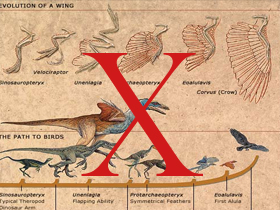The theory of evolution maintains that birds descended from small, carnivorous theropod dinosaurs-in other words, from reptiles. In fact, however, comparison of birds and reptiles reveals that these classes are very different from one another, and that no evolution between them is possible.
There are many structural differences between birds and reptiles, one of the most important of which is bone structure. The bones of dinosaurs are thick and solid. In contrast, the bones of both living and extinct species of birds are hollow, which makes them very light. Reptiles have the slowest metabolism in the living world, while birds hold the record for the fastest. For example, due to its rapid metabolism, a sparrow's body temperature may sometimes reach 48 degrees Celsius. But reptiles are unable to produce their own body heat, warming themselves by means of the Sun's rays. Reptiles consume the least energy, and birds the most.
Despite being an evolutionist, North Carolina University's Professor Alan Feduccia opposes the theory that birds are related to dinosaurs. His opposition to the dino-bird claims is based on scientific findings:
"All in all, I find the whole dino-bird business a total hoax." 93
Larry Martin, a Kansas University authority on ancient birds, also opposes the theory that birds are descended from dinosaurs. In reference to the dilemma in which evolution finds itself, Martin says:
To tell you the truth, if I had to support the dinosaur origin of birds with those characters, I'd be embarrassed every time I had to get up and talk about it. 94
In the face of all the scientific findings, however, the dinosaur-bird evolution scenario, based on no concrete evidence whatsoever, is still stubbornly defended. Certain concepts that represent no evidence for this scenario are superficially portrayed as "evidence" for the link between birds and dinosaurs.
Some evolutionist publications, for instance, suggest that, based on differences in dinosaurs' hip bones, birds evolved from dinosaurs. The hip bone difference in question is that between the Saurischian (reptile-type hip-boned) and Ornithischian (bird-type hip-boned) groups. This concept of dinosaurs with bird-type hips is sometimes perceived as evidence for dinosaur-to-bird evolution.
In fact, however, this provides no support for the claim that dinosaurs are the forerunners of birds. Certain dinosaurs belonging to the Ornithischian group do not resemble birds at all in their other anatomical features. Ankylosaurus, for instance, had short legs, an enormous body and skin covered in armor-like scales, but is a bird-type hip-boned dinosaur belonging to the Ornithischian group. On the other hand, Struthiomimus, some of whose anatomical features may be compared to birds, was thin with long back legs and short forearms, and belongs to the Saurischian group, with reptile-type hip bones.
Hip bone structure, therefore, represents no apparent evidence that dinosaurs and birds are related. The definition of "bird-type" hip-boned dinosaurs is one based solely on similarities, and other major anatomical gulfs between the two groups make it impossible to interpret that one similarity from an evolutionist perspective.
93. 96 Feduccia, A., email to J. David, 26 October, 1999; permission to share this email given 3 November 1999.
94. Pat Shipman, "Birds Do It . . . Did Dinosaurs?", New Scientist, February 1, 1997, p. 28.


